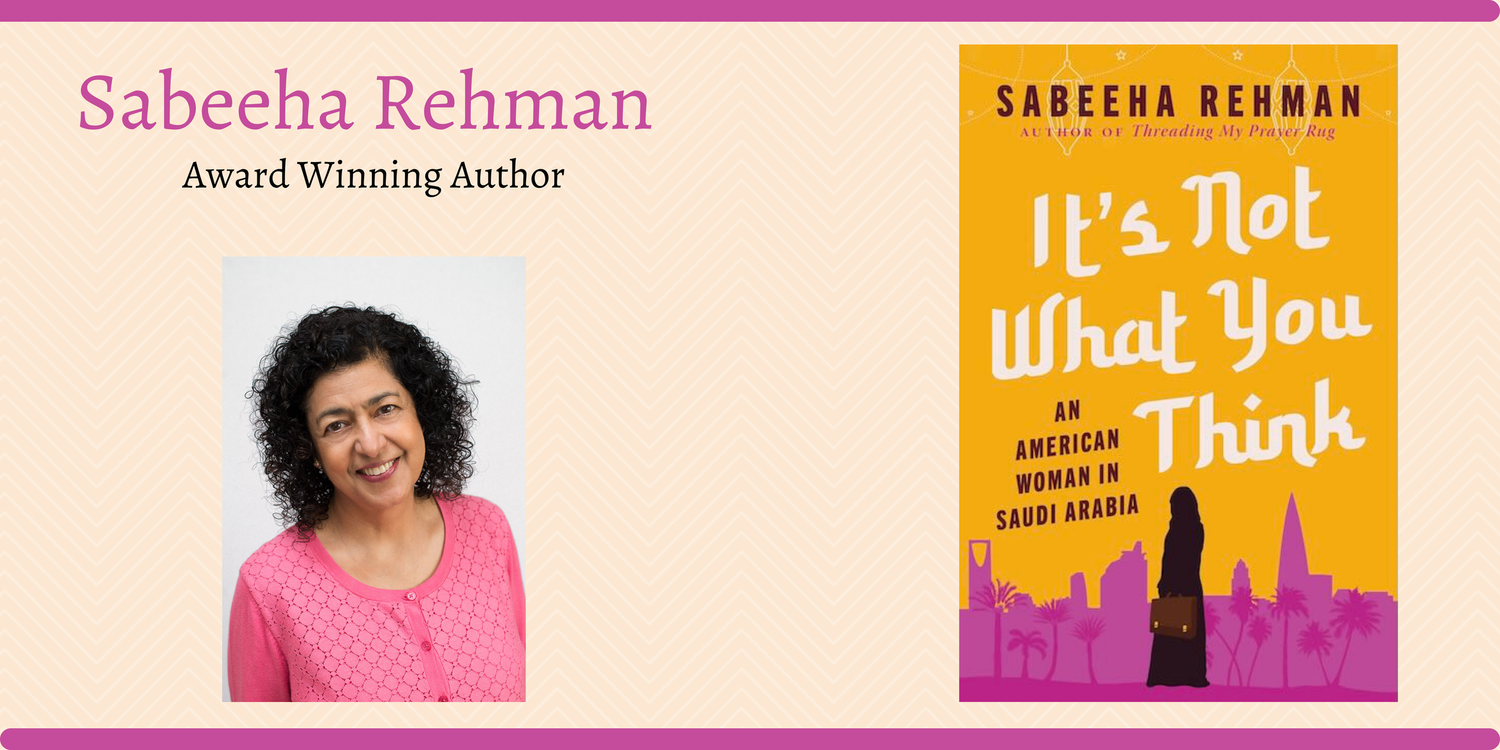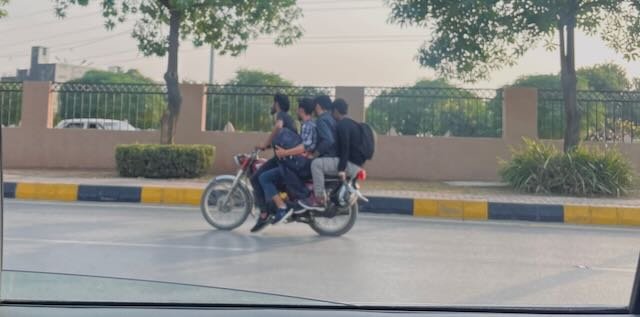I visited the land of my birth last month. So much has changed, and so much remains the same.
For now, let me just talk about getting around on the streets of Lahore, one of the most crowded cities.
What hasn’t changed is the left-hand drive. So, my getting behind the wheel is out of the question. I just will not risk it.
What has changed is the volume of traffic, noticeably the motorcycles. Our granddaughter Laila had a ball just watching the sheer volume, not only of the number of motorcycles but the number of passengers on this one vehicle. The driver, plus his wife behind him, plus his kid between him and his wife, plus a tiny kid in front of him, and plus a baby in his wife’s lap, who is sitting side-saddled, balancing the baby with one hand and her cell phone with the other. That is normal. Laila couldn’t stop taking photos from her car window. Pakistanis have to be one of the most resilient people. If a motorbike is all one has, they will make the most of it, transporting not just people, but grocery bags, lumber . . . think of the stuff you put in your car and imagine it on a motorbike. The sweetest picture I saw was of this young man, carrying a school back-pack, sitting behind his Dad, resting his head on his Dad’s shoulder, and taking a nap on a moving motorbike.
I am not kidding.
He was taking a nap, and during the time we rode parallel to him, he remained fast asleep and didn’t fall off. We kept tracking him until his Dad whizzed through the traffic and sputtered away. That reminds me: the noise. Have you ever been caught in a Harley-Davidson convoy? Imagine being encircled by them. Don’t even think about rolling down your car windows; it’s hazardous to your ears. Helmets? Some wear them, most do not. Remember, not everyone can afford a helmet. Safety is a luxury they cannot afford. At the expense of being presumptuous, I’d say: cut them some slack. And lets acknowledge: Pakistanis are a resilient nation.
Whereas there is an increase in public transportation, as in monorails rising above the landscape of dense urban areas, people prefer to have the convenience of one-stop door-to-door conveyance. Understandable. But it also tells me that the middle class is growing and people who once rode bicycles and tonga horse carriages, now have motor bikes. Which reminds me of something else that has changed. In my visit in 2022, I did not see any tongas. At all. That breed has died. Nor did I see any donkey carts which were once used for lugging stuff like vegetables and lumber. Gone are the animals strolling on the streets, clogging traffic. Buffaloes were a common sight on the roadways when I was there in 2015. All gone.
What hasn’t changed is overloaded buses and rickshaws. People on the roofs of buses, hanging out from the rails, packed into the tiny rickshaws. It breaks your heart to see how much difficulty people face in just trying to get from one place to the next.
Then there is a combo of the old and the new and it works. But you have to know the combination or you will get lost. I did. Get lost, that is. My brother’s driver was driving me to my sister Neena’s house. Aah, that’s another thing that has changed. Everyone who has a car, has a driver—almost everyone. So he was driving me back and I gave him directions the usual way—the American way, that is. I put her address in Google Maps.
“You have arrived at your destination,” Ms. Google said. Except that it wasn’t our destination. Then I noticed that the road sign said ‘Phase 3’. She lives in Phase 2. By the way, I’ll get to road signs in a bit. Don’t let me forget. So I played around with Google Maps but it kept bringing me back to the same wrong destination.
I then entered the address of the main road bordering her house, and after hits and trials, it eventually got me there.
“You should have entered, ‘Near Ace Academy,’ Neena said. Neena is somewhat technologically challenged, but here is what she means: Ever since I was a little girl, I would hear people give verbal directions using landmarks, as in: “When you get to the school, make a left. When you see the big oak tree, make a right. You will pass by a playground. As soon as the playground ends, you will see a white house opposite the water tank. Our house is behind it.”
You get the picture, right? Let’s take it a step further. Postal addresses use landmarks, as in:
135 Lalazar Colony
Opposite St. Mary’s School for boys.
Rawalpindi
The mail man knew St. Mary’s School and could easily locate the house opposite. So Neena wasn’t off when she said that I should have told Google Maps ‘opposite Ace Academy.’ Except that Google Maps is not culturally sensitive. It’s A.I. is way behind. It doesn’t do Opposite, Across, Behind, or Around the corner from. So how do Pakistani’s get around a system that is devoid of street signs? Read on.
The next time I got into the car, the driver asked me, “Do you have the pin location?”
“No.”
I texted my destination-er, who sent me the pin location—his location pinned on a Google Map—and Ms. GPS took over from there, navigating us straight to our destination. Honestly, prior to that, I had never used Pin Location to find my way. But here in Pakistan, that’s the norm. Every driver knows how to navigate a Pin Location.
So, what hasn’t changed is, no road signs. Well, highways have the usual large green overhead road signs, and gated communities have road signs and house numbers on small stone walls at street corners—like apartment buildings it has the range of house numbers—41st Street, House #21 to 50. But most other streets are devoid of signs. What hasn’t changed is that the road signs, wherever they are, are bilingual. English and Urdu. I love that. I love the look, I love the thought behind it.
What has changed is that the traffic has gotten crazier in Lahore. Streets are packed with cars and motorcycles, and when the signal turns red, all the motorcycles meander their way to the front of the cars, roaring and ready to zip off as soon as the light turns green. At crowded intersections, no one follows the rules. They meander through the tiniest opening and swing their way through. I am amazed that accidents don’t occur. Somehow, they squeak through. What I didn’t see was road rage. They are impatient for sure, but not angry. No one yells, no one honks, no one gives the middle finger, they just do what they have to do to get through and get ahead. And I hold my breath.
When I was growing up in Pakistan, there was regard for traffic rules. Now, people will drive through the red signal at night. But just at night.
“You just crossed the red signal,” I yelled. A family member was driving.
“No one is watching at night.”
“No one is watching!” My indignation was evident.
“Once when I stopped at the red light, the car from behind hit into me. The driver of that car said, ‘I thought you will drive through the light.’”
“You can avoid getting hit if you start slowing down when you see the red light,” I said.
He was restrained and didn’t say, “Go back to where you came from.”
Order here:
At a bookstore near you
and
Amazon (hard cover) Amazon (Kindle)
Barnes & Noble Bookshop.org
Indiebound Books-a-Million
Order from:
A bookstore near you
and
Amazon (hardcover) Amazon (Kindle) Bookshop.org Barnes & Noble Indiebound
Books-A-Million Target.com Walmart.com
Order here on Amazon for your:
Paperback
Kindle
Hardcover
Audio, narrated by Yours Truly
Or look for it on the shelf of your neighborhood bookstore.
As an Amazon Associate, I earn from qualifying purchases




